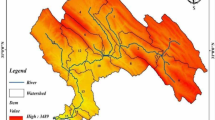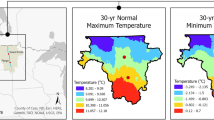Abstract
The artificial ground freezing method (AGF) is widely used in civil and mining engineering, and the thermal regime of frozen soil around the freezing pipe affects the safety of design and construction. The thermal parameters can be truly random due to heterogeneity of the soil properties, which lead to the randomness of thermal regime of frozen soil around the freezing pipe. The purpose of this paper is to study the one-dimensional (1D) random thermal regime problem on the basis of a stochastic analysis model and the Monte Carlo (MC) method. Considering the uncertain thermal parameters of frozen soil as random variables, stochastic processes and random fields, the corresponding stochastic thermal regime of frozen soil around a single freezing pipe are obtained and analyzed. Taking the variability of each stochastic parameter into account individually, the influences of each stochastic thermal parameter on stochastic thermal regime are investigated. The results show that the mean temperatures of frozen soil around the single freezing pipe with three analogy method are the same while the standard deviations are different. The distributions of standard deviation have a great difference at different radial coordinate location and the larger standard deviations are mainly at the phase change area. The computed data with random variable method and stochastic process method have a great difference from the measured data while the computed data with random field method well agree with the measured data. Each uncertain thermal parameter has a different effect on the standard deviation of frozen soil temperature around the single freezing pipe. These results can provide a theoretical basis for the design and construction of AGF.








Similar content being viewed by others
Abbreviations
- Cf :
-
Heat capacity in the frozen area, [J/(m3·°C)]
- C u :
-
Heat capacity in the unfrozen area, [J/(m3·°C)]
- L :
-
Latent heat of melting, [J/m3]
- r 0 :
-
Outer diameter of freezing pipe, [m]
- T :
-
Temperature, [oC]
- T m :
-
Temperature in the frontal freezing surface, [°C]
- ΔT :
-
Phase transition temperature range, [°C]
- T c :
-
Temperature for the outside surface of freezing pipe, [°C]
- T 0 :
-
Initial temperature for the soil around freezing pipe, [°C]
- t :
-
Time, [s]
- L i, L j :
-
Length of local average element, [m]
- x i :
-
Center of local average element, [m]
- λ f :
-
Thermal conductivity in the frozen area, [W/(m·°C)]
- λ u :
-
Thermal conductivity in the unfrozen area, [W/(m·°C)]
- θ :
-
Scale of fluctuation for random field, [m]
References
Andersland O, Ladanyi B (2004) Frozen ground engineering. Wiley, Reston
Li FZ, Xia MP (2004) Study on analytical solution of temperature field of artificial frozen soil by exponent-integral function. J Southeast Univ 34:469–473
Vitel M, Rouabhi A, Tijani M, Guerin F (2015) Modeling heat transfer between a freeze pipe and the surrounding ground during artificial ground freezing activities. Comput Geotech 63:99–111
Jiang BS, Wang JG, Zhou GQ (2009) Analytical calculation of temperature field around a single freezing pipe. J China Univ Min Technol 38:463–466
Zhang C (2015) Study on key construction technologies of the new monolayer freezing shaft lining in deep water-rich bed rock. Ph D Dissertation for China University of Mining and Technology, Jiangsu
Zhou Y, Zhou GQ (2012) Analytical solution for temperature field around a single freezing pipe considering unfrozen water. J China Coal Soc 37:1649–1653
Hu XD, Yu JZ, Ren H, Wang Y, Wang JT (2017) Analytical solution to steady-state temperature field for straight-row-piped freezing based on superposition of thermal potential. Appl Therm Eng 111:223–231
Vanmarcke EH (1983) Random fields: analysis and synthesis. MIT Press, Cambridge
Ramly HE, Morgenstern NR, Cruden DM (2002) Probabilistic slope stability analysis for practice. Can Geotech J 39:665–683
Elkateb T, Chalaturnyk R, Robertson PK (2003) An overview of soil heterogeneity: quantification and implications on geotechnical field problems. Can Geotech J 40:1–15
Lai YM, Li SY, Qi JL, Gao ZH, Chang XX (2008) Strength distributions of warm frozen clay and its stochastic damage constitutive model. Cold Reg Sci Technol 53:200–215
Li SY, Lai YM, Zhang SJ, Liu DR (2009) An improved statistical damage constitutive model for warm frozen clay based on Mohr-coulomb criterion. Cold Reg Sci Technol 57:154–159
Dasaka SM, Zhang LM (2012) Spatial variability of in situ weathered soil. Geotechnique 62(5):375–384
Bong T, Son Y, Noh S, Park J (2014) Probabilistic analysis of consolidation that considers spatial variability using the stochastic response surface method. Soils Found 54(5):917–926
Madera AG, Sotnikov AN (1996) Method for analyzing stochastic heat transfer in a fluid flow. Appl Math Model 20:588–592
Hien TD, Kleiber M (1997) Stochastic finite element modeling in linear transient heat transfer. Comput Methods Appl Mech Eng 144:111–124
Xiu DB, Karniadakis GE (2003) A new stochastic approach to transient heat conduction modeling with uncertainty. Int J Heat Mass Transf 46:4681–4693
Emery AF (2004) Solving stochastic heat transfer problems. Eng Anal Bound Elem 28:279–291
Liu ZQ, Lai YM, Zhang MY, Zhang XF (2007) Numerical analysis for random temperature fields of embankment in cold regions. Sci China Ser D Earth Sci 50(3):404–410
Liu ZQ, Yang WH, Wei J (2014) Analysis of random temperature field for freeway with wide subgrade in cold regions. Cold Reg Sci Technol 106-107:22–27
Wang T, Zhou GQ, Wang JZ, Zhao XD, Yin QX, Xia LJ, Liu YY (2015) Stochastic analysis model of uncertain temperature characteristics for embankment in warm permafrost regions. Cold Reg Sci Technol 109:43–52
Wang T, Zhou GQ, Wang JZ, Zhao XD (2016) Stochastic analysis for the uncertain temperature field of tunnel in cold regions. Tunn Undergr Space Technol 59:7–15
Wang T, Zhou GQ, Wang JZ, Zhao XD (2016) Stochastic analysis of uncertain thermal characteristic of foundation soils surrounding the crude oil pipeline in permafrost regions. Appl Therm Eng 99:591–598
Wang T, Zhou GQ, Wang JZ, Zhao XD, Chen X (2017) Estimation on the influence of uncertain parameters on stochastic thermal regime of embankment in permafrost regions. Heat Mass Transf 53:1113–1122
Bonacina C, Comini G, Fasano A, Primicerio M (1973) Numerical solution of phase-change problems. Int J Heat Mass Transf 16:1825–1832
Liu JK, Tian YH (2002) Numerical studies for the thermal regime of a roadbed with insulation on permafrost. Cold Reg Sci Technol 35:1–13
Lewis RW, Morgan K, Thomas HR, Seetharamu KN (1996) The finite element method in heat transfer analysis. Wiley, New York
Zhu H, Zhang LM (2013) Characterizing geotechnical anisotropic spatial variations using random field theory. Can Geotech J 50:723–773
Vanmarcke E, Shinozuka M, Nakagiri S, Schueller GI, Grigoriu M (1986) Random fields and stochastic finite elements. Struct Saf 3:143–166
Wang JZ (2008) Research on the mechanical properties of inhomogeneous thick frozen wall in deep alluvium. Ph D dissertation for China University of Mining and Technology, Jiangsu
Hu K, Zhou GQ, Jing LJ, Wang JZ, Zhou J, Wei YZ (2010) Experimental research on multi-circle freezing temperature field for thick top soil. J Min Saf Eng 27(2):149–153
Acknowledgments
The authors thank the three anonymous reviewers for their comments and advice. This research was supported by the National Natural Science Foundation of China (Grant No. 51604265 and 51323004), the 111 Project (Grant No. B14021) and the China Postdoctoral Science Foundation funded project (Grant No. 2017M620229).
Author information
Authors and Affiliations
Corresponding author
Rights and permissions
About this article
Cite this article
Wang, T., Zhou, G., Wang, J. et al. Stochastic analysis of uncertain thermal parameters for random thermal regime of frozen soil around a single freezing pipe. Heat Mass Transfer 54, 2845–2852 (2018). https://doi.org/10.1007/s00231-018-2327-1
Received:
Accepted:
Published:
Issue Date:
DOI: https://doi.org/10.1007/s00231-018-2327-1




